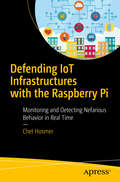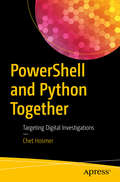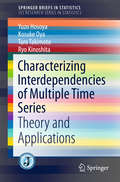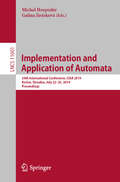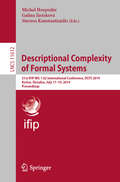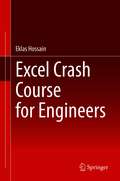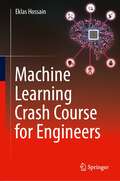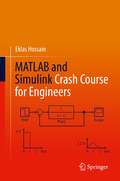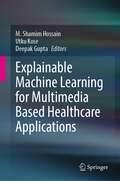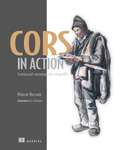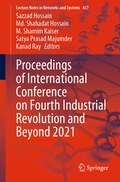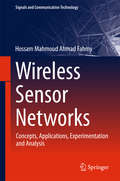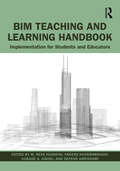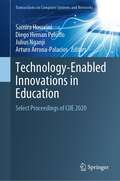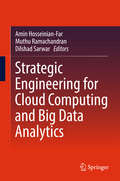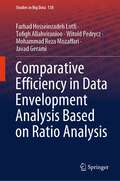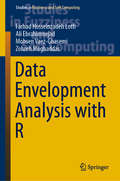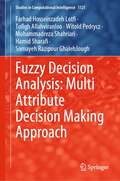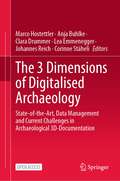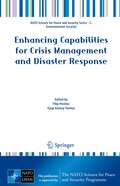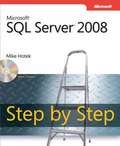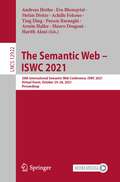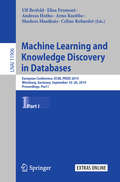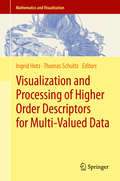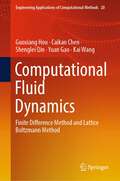- Table View
- List View
Defending IoT Infrastructures with the Raspberry Pi: Monitoring And Detecting Nefarious Behavior In Real Time
by Chet HosmerApply a methodology and practical solutions for monitoring the behavior of the Internet of Things (IoT), industrial control systems (ICS), and other critical network devices with the inexpensive Raspberry Pi. With this book, you will master passive monitoring and detection of aberrant behavior, and learn how to generate early indications and warning of attacks targeting IoT, ICS, and other critical network resources. Defending IoT Infrastructures with the Raspberry Pi provides techniques and scripts for the discovery of dangerous data leakage events emanating from IoT devices. Using Raspbian Linux and specialized Python scripts, the book walks through the steps necessary to monitor, detect, and respond to attacks targeting IoT devices. There are several books that cover IoT, IoT security, Raspberry Pi, and Python separately, but this book is the first of its kind to put them all together. It takes a practical approach, providing an entry point and level playing field for a wide range of individuals, small companies, researchers, academics, students, and hobbyists to participate. What You’ll Learn Create a secure, operational Raspberry Pi IoT sensorConfigure and train the sensor using “normal” IoT behaviorEstablish analytics for detecting aberrant activitiesGenerate real-time alerts to preempt attacksIdentify and report data-leakage events originating from IoT devicesDevelop custom Python applications for cybersecurity Who This Book Is For Cybersecurity specialists, professors teaching in undergraduate and graduate programs in cybersecurity, students in cybersecurity and computer science programs, software developers and engineers developing new cybersecurity defenses, incident response teams, software developers and engineers in general, and hobbyists wanting to expand the application of Raspberry Pi into both IoT and cybersecurity
PowerShell and Python Together: Targeting Digital Investigations
by Chet HosmerBring together the Python programming language and Microsoft’s PowerShell to address digital investigations and create state-of-the-art solutions for administrators, IT personnel, cyber response teams, and forensic investigators.You will learn how to join PowerShell's robust set of commands and access to the internals of both the MS Windows desktop and enterprise devices and Python's rich scripting environment allowing for the rapid development of new tools for investigation, automation, and deep analysis.PowerShell and Python Together takes a practical approach that provides an entry point and level playing field for a wide range of individuals, small companies, researchers, academics, students, and hobbyists to participate. What You’ll Learn Leverage the internals of PowerShell for: digital investigation, incident response, and forensicsLeverage Python to exploit already existing PowerShell CmdLets and aliases to build new automation and analysis capabilitiesCreate combined PowerShell and Python applications that provide: rapid response capabilities to cybersecurity events, assistance in the precipitous collection of critical evidence (from the desktop and enterprise), and the ability to analyze, reason about, and respond to events and evidence collected across the enterprise Who This Book Is For System administrators, IT personnel, incident response teams, forensic investigators, professors teaching in undergraduate and graduate programs in cybersecurity, students in cybersecurity and computer science programs, and software developers and engineers developing new cybersecurity defenses
Characterizing Interdependencies of Multiple Time Series: Theory and Applications (SpringerBriefs in Statistics)
by Yuzo Hosoya Kosuke Oya Taro Takimoto Ryo KinoshitaThis book introduces academic researchers and professionals to the basic concepts and methods for characterizing interdependencies of multiple time series in the frequency domain. Detecting causal directions between a pair of time series and the extent of their effects, as well as testing the non existence of a feedback relation between them, have constituted major focal points in multiple time series analysis since Granger introduced the celebrated definition of causality in view of prediction improvement. Causality analysis has since been widely applied in many disciplines. Although most analyses are conducted from the perspective of the time domain, a frequency domain method introduced in this book sheds new light on another aspect that disentangles the interdependencies between multiple time series in terms of long-term or short-term effects, quantitatively characterizing them. The frequency domain method includes the Granger noncausality test as a special case. Chapters 2 and 3 of the book introduce an improved version of the basic concepts for measuring the one-way effect, reciprocity, and association of multiple time series, which were originally proposed by Hosoya. Then the statistical inferences of these measures are presented, with a focus on the stationary multivariate autoregressive moving-average processes, which include the estimation and test of causality change. Empirical analyses are provided to illustrate what alternative aspects are detected and how the methods introduced here can be conveniently applied. Most of the materials in Chapters 4 and 5 are based on the authors' latest research work. Subsidiary items are collected in the Appendix.
Implementation and Application of Automata: 24th International Conference, CIAA 2019, Košice, Slovakia, July 22–25, 2019, Proceedings (Lecture Notes in Computer Science #11601)
by Michal Hospodár Galina JiráskováThis book constitutes the proceedings of the 24th International Conference on Implementation and Application of Automata, CIAA 2019, held in Kosice, Slovakia, in July 2019.The 17 regular papers presented together with 2 invited papers in this book were carefully reviewed and selected from 29 initial submissions. The topics of the papers include complexity of languages and language operations, regular expressions, picture languages, jumping automata, input driven and two-dimensional automata, tree languages and tree transducers, architecture of oritatami systems, intruder deduction problem, context sensitive ash codes, rational relations, and algorithms for manipulating sequence binary decision diagrams
Descriptional Complexity of Formal Systems: 21st IFIP WG 1.02 International Conference, DCFS 2019, Košice, Slovakia, July 17–19, 2019, Proceedings (Lecture Notes in Computer Science #11612)
by Michal Hospodár Galina Jirásková Stavros KonstantinidisThis book constitutes the proceedings of the 21st International Conference on Descriptional Complexity of Format Systems, DCFS 2019, held in Košice, Slovakia, in July 2019. The 18 full papers presented in this volume were carefully reviewed and selected from 25 submissions. The book also contains 4 invited talks. They deal with all aspects of descriptional complexity and costs of description of objects in various computational models, such as Turing machines, pushdown automata, finite automata, grammars, and others.
Excel Crash Course for Engineers
by Eklas HossainExcel Crash Course for Engineers is a reader-friendly introductory guide to the features, functions, and applications of Microsoft Excel in engineering. The book provides readers with real-world examples and exercises that are directly related to engineering, and offers highly illustrated, step-by-step demonstrations of techniques to solve and visualize engineering problems and situations. The book includes an introduction to MS Excel, along with in-depth coverage of graphing and charting, functions and formulae, Excel's Visual Basic for Applications (VBA) programming language, and engineering data analysis. This powerful tutorial is a great resource for students, engineers, and other busy technical professionals who need to quickly acquire a solid understanding of Excel.
Machine Learning Crash Course for Engineers
by Eklas HossainMachine Learning Crash Course for Engineers is a reader-friendly introductory guide to machine learning algorithms and techniques for students, engineers, and other busy technical professionals. The book focuses on the application aspects of machine learning, progressing from the basics to advanced topics systematically from theory to applications and worked-out Python programming examples. It offers highly illustrated, step-by-step demonstrations that allow readers to implement machine learning models to solve real-world problems. This powerful tutorial is an excellent resource for those who need to acquire a solid foundational understanding of machine learning quickly.
MATLAB and Simulink Crash Course for Engineers
by Eklas HossainMATLAB and Simulink Crash Course for Engineers is a reader-friendly introductory guide to the features, functions, and applications of MATLAB and Simulink. The book provides readers with real-world examples, exercises, and applications, and offers highly illustrated, step-by-step demonstrations of techniques for the modelling and simulation of complex systems. MATLAB coverage includes vectors and matrices, programs and functions, complex numbers, visualization, solving equations, numerical methods, optimization problems, and graphical user interfaces. The Simulink coverage includes commonly used Simulink blocks, control system simulation, electrical circuit analysis, electric power systems, power electronics, and renewable energy technology. This powerful tutorial is a great resource for students, engineers, and other busy technical professionals who need to quickly acquire a solid understanding of MATLAB and Simulink.
Explainable Machine Learning for Multimedia Based Healthcare Applications
by M. Shamim Hossain Utku Kose Deepak GuptaThis book covers the latest research studies regarding Explainable Machine Learning used in multimedia-based healthcare applications. In this context, the content includes not only introductions for applied research efforts but also theoretical touches and discussions targeting open problems as well as future insights. In detail, a comprehensive topic coverage is ensured by focusing on remarkable healthcare problems solved with Artificial Intelligence. Because today’s conditions in medical data processing are often associated with multimedia, the book considers research studies with especially multimedia data processing.
CORS in Action: Creating and consuming cross-origin APIs
by Monsur HossainSummaryCORS in Action introduces Cross-Origin Resource Sharing (CORS) from both the server and the client perspective. It starts with the basics: how to make CORS requests and how to implement CORS on the server. It then explores key details such as performance, debugging, and security. API authors will learn how CORS opens their APIs to a wider range of users. JavaScript developers will find valuable techniques for building rich web apps that can take advantage of APIs hosted anywhere. The techniques described in this book are especially applicable to mobile environments, where browsers are guaranteed to support CORS. Purchase of the print book includes a free eBook in PDF, Kindle, and ePub formats from Manning Publications. About the BookSuppose you need to share some JSON data with another application or service. If everything is hosted on one domain, it's a snap. But if the data is on another domain, the browser's "same-origin" policy stops you cold. CORS is a new web standard that enables safe cross-domain access without complex server-side code. Mastering CORS makes it possible for web and mobile applications to share data simply and securely. CORS in Action introduces CORS from both the server and the client perspective. It starts with making and enabling CORS requests and then explores performance, debugging, and security. You'll learn to build apps that can take advantage of APIs hosted anywhere and how to write APIs that expand your products to a wider range of users. For web developers comfortable with JavaScript. No experience with CORS is assumed.What's InsideCORS from the ground upServing and consuming cross-domain dataBest practices for building CORS APIsWhen to use CORS alternatives like JSON-P and proxiesAbout the AuthorMonsur Hossain is an engineer at Google who has worked on API-related projects such as the Google JavaScript Client, the APIs Discovery Service, and CORS support for Google APIs.Table of ContentsPART 1 INTRODUCING CORSThe Core of CORSMaking CORS requestsPART 2 CORS ON THE SERVERHandling CORS requestsHandling preflight requestsCookies and response headersBest practicesPART 3 DEBUGGING CORS REQUESTSDebugging CORS requests APPENDIXESCORS referenceConfiguring your environmentWhat is CSRF?Other cross-origin techniques
Proceedings of International Conference on Fourth Industrial Revolution and Beyond 2021 (Lecture Notes in Networks and Systems #437)
by Sazzad Hossain Md. Shahadat Hossain M. Shamim Kaiser Satya Prasad Majumder Kanad RayThis book includes papers in the research area of artificial intelligence, robotics and automation, IoT smart agriculture, data analysis and cloud computing, communication and technology, and signal and natural language processing. The book is a collection of research papers presented at the First International Conference on Fourth Industrial Revolution and Beyond (IC4IR 2021) organized by University Grants Commission of Bangladesh in association with IEEE Computer Society Bangladesh Chapter and Bangladesh Computer Society during December 10–11, 2021.
Wireless Sensor Networks
by Hossam Mahmoud Ahmad FahmyThisbook focuses on the principles of wireless sensor networks (WSNs), theirapplications, and their analysis tools, with meticulous attention paid todefinitions and terminology. This book presents the adopted technologies andtheir manufacturers in detail, making WSNs tangible for the reader. Inintroductory computer networking books, chapter sequencing follows thebottom-up or top-down architecture of the 7-layer protocol. This bookaddresses subsequent steps in this process, both horizontally and vertically,thus fostering a clearer and deeper understanding through chapters thatelaborate on WSN concepts and issues. With such depth, this book is intended for a wide audience; it ismeant to be a helper and motivator for senior undergraduates, postgraduates,researchers, and practitioners. It lays out important concepts and WSN-relateapplications; uses appropriate literature to back research and practicalissues; and focuses on new trends. Senior undergraduate students can use it tofamiliarize themselves with conceptual foundations and practical projectimplementations. For graduate students and researchers, test beds andsimulators provide vital insights into analysis methods and tools for WSNs. Lastly, in addition to applications and deployment, practitioners will be ableto learn more about WSN manufacturers and components within several platformsand test beds.
BIM Teaching and Learning Handbook: Implementation for Students and Educators
by M. Reza Hosseini Farzad Khosrowshahi Ajibade Aibinu Sepehr AbrishamiThis book is the essential guide to the pedagogical and industry-inspired considerations that must shape how BIM is taught and learned. It will help academics and professional educators to develop programmes that meet the competences required by professional bodies and prepare both graduates and existing practitioners to advance the industry towards higher efficiency and quality. To date, systematic efforts to integrate pedagogical considerations into the way BIM is learned and taught remain non-existent. This book lays the foundation for forming a benchmark around which such an effort is made. It offers principles, best practices, and expected outcomes necessary to BIM curriculum and teaching development for construction-related programs across universities and professional training programmes. The aim of the book is to: Highlight BIM skill requirements, threshold concepts, and dimensions for practice; Showcase and introduce tried-and-tested practices and lessons learned in developing BIM-related curricula from leading educators; Recognise and introduce the baseline requirements for BIM education from a pedagogical perspective; Explore the challenges, as well as remedial solutions, pertaining to BIM education at tertiary education; Form a comprehensive point of reference, covering the essential concepts of BIM, for students; Promote and integrate pedagogical consideration into BIM education. This book is essential reading for anyone involved in BIM education, digital construction, architecture, and engineering, and for professionals looking for guidance on what the industry expects when it comes to BIM competency.
Technology-Enabled Innovations in Education: Select Proceedings of CIIE 2020 (Transactions on Computer Systems and Networks)
by Samira Hosseini Diego Hernan Peluffo Julius Nganji Arturo Arrona-PalaciosThis book contains peer-reviewed selected papers of the 7th International Conference on Educational Innovation (CIIE 2020). It presents excellent educational practices and technologies complemented by various innovative approaches that enhance educational outcomes. In line with the Sustainable Development Goal 4 of UNESCO in the 2030 agenda, CIIE 2020 has attempted to “ensure inclusive and equitable quality education and promote lifelong learning opportunities for all.” The CIIE 2020 proceeding offers diverse dissemination of innovations, knowledge, and lessons learned to familiarize readership with new pedagogical-oriented, technology-driven educational strategies along with their applications to emphasize their impact on a large spectrum of stakeholders including students, teachers and professors, administrators, policymakers, entrepreneurs, governments, international organizations, and NGOs.
Strategic Engineering for Cloud Computing and Big Data Analytics
by Amin Hosseinian-Far Muthu Ramachandran Dilshad SarwarThis book demonstrates the use of a wide range of strategic engineering concepts, theories and applied case studies to improve the safety, security and sustainability of complex and large-scale engineering and computer systems. It first details the concepts of system design, life cycle, impact assessment and security to show how these ideas can be brought to bear on the modeling, analysis and design of information systems with a focused view on cloud-computing systems and big data analytics. This informative book is a valuable resource for graduate students, researchers and industry-based practitioners working in engineering, information and business systems as well as strategy.
Comparative Efficiency in Data Envelopment Analysis Based on Ratio Analysis (Studies in Big Data #138)
by Farhad Hosseinzadeh Lotfi Tofigh Allahviranloo Witold Pedrycz Mohammad Reza Mozaffari Javad GeramiThe combination of DEA and ratio analysis is introduced as a suitable field for evaluating the performance of DMUs. In this regard, DEA-R is also proposed as a hybrid technique for calculating efficiency, ranking DMUs, and finding efficient faces. Therefore, the relationship between DEA and DEA-R provides a suitable field for researchers in the field of evaluating the performance of DMUs. The audience of this book is not limited to researchers in mathematics fields, but experts and students in industrial engineering and management fields also benefit from the topics of this book.
Data Envelopment Analysis with R (Studies in Fuzziness and Soft Computing #386)
by Farhad Hosseinzadeh Lotfi Ali Ebrahimnejad Mohsen Vaez-Ghasemi Zohreh MoghaddasThis book introduces readers to the use of R codes for optimization problems. First, it provides the necessary background to understand data envelopment analysis (DEA), with a special emphasis on fuzzy DEA. It then describes DEA models, including fuzzy DEA models, and shows how to use them to solve optimization problems with R. Further, it discusses the main advantages of R in optimization problems, and provides R codes based on real-world data sets throughout. Offering a comprehensive review of DEA and fuzzy DEA models and the corresponding R codes, this practice-oriented reference guide is intended for masters and Ph.D. students in various disciplines, as well as practitioners and researchers.
Fuzzy Decision Analysis: Multi Attribute Decision Making Approach (Studies in Computational Intelligence #1121)
by Farhad Hosseinzadeh Lotfi Somayeh Razipour GhalehJough Tofigh Allahviranloo Witold Pedrycz Mohammadreza Shahriari Hamid SharafiAuthored by a leading expert in the field, this book introduces an innovative methodology that harnesses the power of fuzzy logic to enhance decision-making in multi-attribute scenarios. In a world of complexity and uncertainty, effective decision-making is paramount. Springer proudly presents a cutting-edge publication that revolutionizes decision analysis: "Fuzzy Decision Analysis: Multi-attribute Decision-Making Approach." This book stands at the forefront of decision analysis, introducing the integration of fuzzy logic into multi-attribute decision-making. It is a transformative journey into the realm of advanced decision analysis. It book not only equips you with the knowledge to comprehend the theoretical underpinnings but also empowers you to apply these insights in practical scenarios. This book serves as your indispensable companion. Its comprehensive coverage serves as a beacon, guiding you through the intricate maze of fuzzy logic and multi-attribute decision-making, ultimately empowering you to embrace innovation and master the art of making well-informed decisions in an ever-changing world.
The 3 Dimensions of Digitalised Archaeology: State-of-the-Art, Data Management and Current Challenges in Archaeological 3D-Documentation
by Marco Hostettler Anja Buhlke Clara Drummer Lea Emmenegger Johannes Reich Corinne StäheliThis open access book aims to provide an overview of state-of-the-art approaches to 3D documentation from a practical perspective and formulate the most important areas for future developments. Bringing together a wide range of case studies, examples of best practice approaches, workflows, and first attempts to establish sustainable solutions to pressing problems, this book offers readers current practical advice on how to approach 3D archaeology and cultural heritage.Divided into five parts, this book begins with an overview of 3D archaeology in its present state. It goes on to give insights into the development of the technology and recent cutting-edge applications. The next section identifies current challenges in 3D archaeology and then presents approaches and solutions for data management of a large number of 3D objects and ways to ensure sustainable solutions for the archiving of the produced data. This book will be of interest to researchers working in the fields of archaeology, heritage management, and digital humanities in general.
Enhancing Capabilities for Crisis Management and Disaster Response (NATO Science for Peace and Security Series C: Environmental Security)
by Filip Hostiuc Eyup Kuntay TurmusScience for Peace and Security (SPS) cooperation brings together NATO & partners to address common security concerns reflected in the so-called SPS Key Priorities. These include emerging security challenges such as terrorism, cyber defense or energy security, as well as human and social aspects of security, support to NATO-led mission and operation, advanced technologies with security applications, and early warning. The SPS project “Advanced Civil Emergency Coordination Pilot in the Western Balkans” addresses several of these areas. As a key regional SPS flagship project, it helps to build capacity in response to a concrete security challenge. The Western Balkans is a region frequently affected by natural disasters and the pilot project provides emergency responders in the region with an incident command system that allows sharing information about disasters in a fast and easy way, enhancing situational awareness and building capacity in the area of civil emergency coordination.
Microsoft® SQL Server® 2008 Step by Step
by Mike HotekTeach yourself SQL Server 2008--one step at a time. Get the practical guidance you need to build database solutions that solve real-world business problems. Learn to integrate SQL Server data in your applications, write queries, develop reports, and employ powerful business intelligence systems. Discover how to: Install and work with core components and tools Create tables and index structures Manipulate and retrieve data Secure, manage, back up, and recover databases Apply tuning plus optimization techniques to generate high-performing database applications Optimize availability through clustering, database mirroring, and log shipping Tap business intelligence tools--Reporting, Analysis, and Integration Services CD features: Practice exercises and code samples Fully searchable eBook A Note Regarding the CD or DVD The print version of this book ships with a CD or DVD. For those customers purchasing one of the digital formats in which this book is available, we are pleased to offer the CD/DVD content as a free download via OReilly Medias Digital Distribution services. To download this content, please visit OReillys web site, search for the title of this book to find its catalog page, and click on the link below the cover image (Examples, Companion Content, or Practice Files). Note that while we provide as much of the media content as we are able via free download, we are sometimes limited by licensing restrictions. Please direct any questions or concerns to booktech@oreilly.com.
The Semantic Web – ISWC 2021: 20th International Semantic Web Conference, ISWC 2021, Virtual Event, October 24–28, 2021, Proceedings (Lecture Notes in Computer Science #12922)
by Andreas Hotho Mauro Dragoni Armin Haller Ying Ding Eva Blomqvist Stefan Dietze Achille Fokoue Payam Barnaghi Harith AlaniThis book constitutes the proceedings of the 20th International Semantic Web Conference, ISWC 2021, which took place in October 2021. Due to COVID-19 pandemic the conference was held virtually. The papers included in this volume deal with the latest advances in fundamental research, innovative technology, and applications of the Semantic Web, linked data, knowledge graphs, and knowledge processing on the Web. Papers are organized in a research track, resources and in-use track. The research track details theoretical, analytical and empirical aspects of the Semantic Web and its intersection with other disciplines. The resources track promotes the sharing of resources which support, enable or utilize semantic web research, including datasets, ontologies, software, and benchmarks. And finally, the in-use-track is dedicated to novel and significant research contributions addressing theoretical, analytical and empirical aspects of the Semantic Web and its intersection with other disciplines.
Machine Learning and Knowledge Discovery in Databases: European Conference, ECML PKDD 2019, Würzburg, Germany, September 16–20, 2019, Proceedings, Part I (Lecture Notes in Computer Science #11906)
by Andreas Hotho Elisa Fromont Arno Knobbe Ulf Brefeld Marloes Maathuis Céline RobardetThe three volume proceedings LNAI 11906 – 11908 constitutes the refereed proceedings of the European Conference on Machine Learning and Knowledge Discovery in Databases, ECML PKDD 2019, held in Würzburg, Germany, in September 2019.The total of 130 regular papers presented in these volumes was carefully reviewed and selected from 733 submissions; there are 10 papers in the demo track. The contributions were organized in topical sections named as follows: Part I: pattern mining; clustering, anomaly and outlier detection, and autoencoders; dimensionality reduction and feature selection; social networks and graphs; decision trees, interpretability, and causality; strings and streams; privacy and security; optimization. Part II: supervised learning; multi-label learning; large-scale learning; deep learning; probabilistic models; natural language processing. Part III: reinforcement learning and bandits; ranking; applied data science: computer vision and explanation; applied data science: healthcare; applied data science: e-commerce, finance, and advertising; applied data science: rich data; applied data science: applications; demo track. Chapter "Heavy-tailed Kernels Reveal a Finer Cluster Structure in t-SNE Visualisations" is available open access under a Creative Commons Attribution 4.0 International License via link.springer.com.
Visualization and Processing of Higher Order Descriptors for Multi-Valued Data
by Ingrid Hotz Thomas SchultzModern imaging techniques and computational simulations yield complex multi-valued data that require higher-order mathematical descriptors. This book addresses topics of importance when dealing with such data, including frameworks for image processing, visualization and statistical analysis of higher-order descriptors. It also provides examples of the successful use of higher-order descriptors in specific applications and a glimpse of the next generation of diffusion MRI. To do so, it combines contributions on new developments, current challenges in this area and state-of-the-art surveys. Compared to the increasing importance of higher-order descriptors in a range of applications, tools for analysis and processing are still relatively hard to come by. Even though application areas such as medical imaging, fluid dynamics and structural mechanics are very different in nature they face many shared challenges. This book provides an interdisciplinary perspective on this topic with contributions from key researchers in disciplines ranging from visualization and image processing to applications. It is based on the 5th Dagstuhl seminar on Visualization and Processing of Higher Order Descriptors for Multi-Valued Data. This book will appeal to scientists who are working to develop new analysis methods in the areas of image processing and visualization, as well as those who work with applications that generate higher-order data or could benefit from higher-order models and are searching for novel analytical tools.
Computational Fluid Dynamics: Finite Difference Method and Lattice Boltzmann Method (Engineering Applications of Computational Methods #20)
by Guoxiang Hou Caikan Chen Shenglei Qin Yuan Gao Kai WangThis book provides a concise and comprehensive introduction to several basic methods with more attention to their theoretical basis and applications in fluid dynamics. Furthermore, some new ideas are presented in this book, for example, a method to solve the transition matrix by difference operator transformation. For this method, the book gives the definition of Fourier integral transformation of translation operator, and proves the transition matrix equaling to the differential operator transformation, so that it is extended to general situations of explicit, implicit, multi-layer difference equations, etc. This flexible approach is also used in the differential part. In addition, the book also includes six types of equivalent stability definitions in two ways and deeply analyzes their errors, stabilities and convergences of the difference equations. What is more important, some new scientific contributions on lattice Boltzmann method (LBM) in recent years are presented in the book as well. The authors write the book combining their ten years teaching experience and research results and this book is intended for graduate students who are interested in the area of computational fluid dynamics (CFD). Authors list some new research achievements, such as simplified lattice Boltzmann method, the simplified lattice Boltzmann flux solver and discrete unified gas kinetic scheme, and expect that this new information could give readers possible further investigating ideas in their future research on CFD area.
